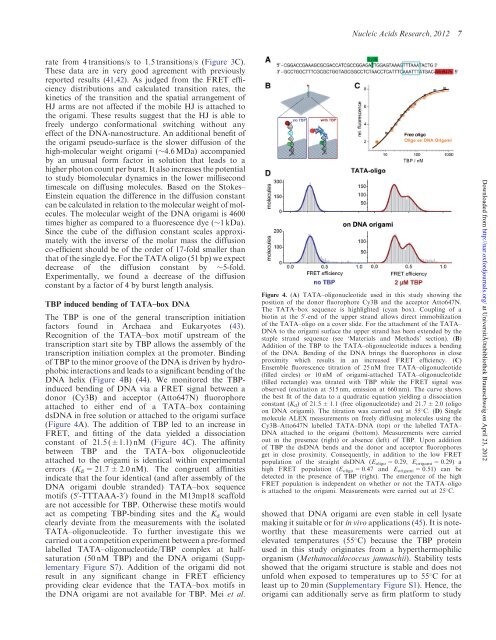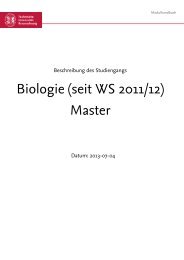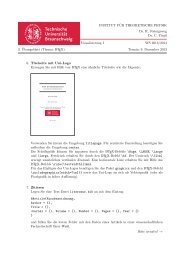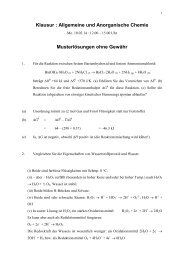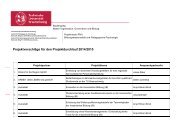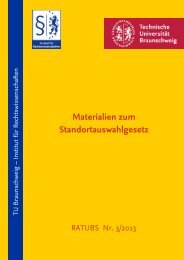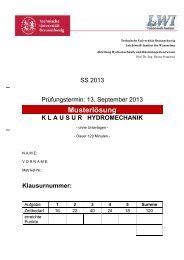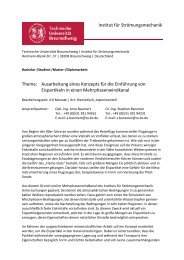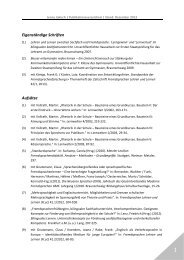L - Technische Universität Braunschweig
L - Technische Universität Braunschweig
L - Technische Universität Braunschweig
You also want an ePaper? Increase the reach of your titles
YUMPU automatically turns print PDFs into web optimized ePapers that Google loves.
Nucleic Acids Research, 2012 7<br />
rate from 4 transitions/s to 1.5 transitions/s (Figure 3C).<br />
These data are in very good agreement with previously<br />
reported results (41,42). As judged from the FRET efficiency<br />
distributions and calculated transition rates, the<br />
kinetics of the transition and the spatial arrangement of<br />
HJ arms are not affected if the mobile HJ is attached to<br />
the origami. These results suggest that the HJ is able to<br />
freely undergo conformational switching without any<br />
effect of the DNA-nanostructure. An additional benefit of<br />
the origami pseudo-surface is the slower diffusion of the<br />
high-molecular weight origami (4.6 MDa) accompanied<br />
by an unusual form factor in solution that leads to a<br />
higher photon count per burst. It also increases the potential<br />
to study biomolecular dynamics in the lower millisecond<br />
timescale on diffusing molecules. Based on the Stokes–<br />
Einstein equation the difference in the diffusion constant<br />
can be calculated in relation to the molecular weight of molecules.<br />
The molecular weight of the DNA origami is 4600<br />
times higher as compared to a fluorescence dye (1 kDa).<br />
Since the cube of the diffusion constant scales approximately<br />
with the inverse of the molar mass the diffusion<br />
co-efficient should be of the order of 17-fold smaller than<br />
that of the single dye. For the TATA oligo (51 bp) we expect<br />
decrease of the diffusion constant by 5-fold.<br />
Experimentally, we found a decrease of the diffusion<br />
constant by a factor of 4 by burst length analysis.<br />
TBP induced bending of TATA–box DNA<br />
The TBP is one of the general transcription initiation<br />
factors found in Archaea and Eukaryotes (43).<br />
Recognition of the TATA–box motif upstream of the<br />
transcription start site by TBP allows the assembly of the<br />
transcription initiation complex at the promoter. Binding<br />
of TBP to the minor groove of the DNA is driven by hydrophobic<br />
interactions and leads to a significant bending of the<br />
DNA helix (Figure 4B) (44). We monitored the TBPinduced<br />
bending of DNA via a FRET signal between a<br />
donor (Cy3B) and acceptor (Atto647N) fluorophore<br />
attached to either end of a TATA–box containing<br />
dsDNA in free solution or attached to the origami surface<br />
(Figure 4A). The addition of TBP led to an increase in<br />
FRET, and fitting of the data yielded a dissociation<br />
constant of 21.5 (±1.1) nM (Figure 4C). The affinity<br />
between TBP and the TATA–box oligonucleotide<br />
attached to the origami is identical within experimental<br />
errors (K d = 21.7 ± 2.0 nM). The congruent affinities<br />
indicate that the four identical (and after assembly of the<br />
DNA origami double stranded) TATA–box sequence<br />
motifs (5 0 -TTTAAA-3 0 ) found in the M13mp18 scaffold<br />
are not accessible for TBP. Otherwise these motifs would<br />
act as competing TBP-binding sites and the K d would<br />
clearly deviate from the measurements with the isolated<br />
TATA–oligonucleotide. To further investigate this we<br />
carried out a competition experiment between a pre-formed<br />
labelled TATA–oligonucleotide/TBP complex at halfsaturation<br />
(50 nM TBP) and the DNA origami (Supplementary<br />
Figure S7). Addition of the origami did not<br />
result in any significant change in FRET efficiency<br />
providing clear evidence that the TATA–box motifs in<br />
the DNA origami are not available for TBP. Mei et al.<br />
Figure 4. (A) TATA–oligonucleotide used in this study showing the<br />
position of the donor fluorophore Cy3B and the acceptor Atto647N.<br />
The TATA–box sequence is highlighted (cyan box). Coupling of a<br />
biotin at the 5 0 -end of the upper strand allows direct immobilization<br />
of the TATA–oligo on a cover slide. For the attachment of the TATA–<br />
DNA to the origami surface the upper strand has been extended by the<br />
staple strand sequence (see ‘Materials and Methods’ section). (B)<br />
Addition of the TBP to the TATA–oligonucleotide induces a bending<br />
of the DNA. Bending of the DNA brings the fluorophores in close<br />
proximity which results in an increased FRET efficiency. (C)<br />
Ensemble fluorescence titration of 25 nM free TATA–oligonucleotide<br />
(filled circles) or 10 nM of origami-attached TATA–oligonucleotide<br />
(filled rectangle) was titrated with TBP while the FRET signal was<br />
observed (excitation at 515 nm, emission at 660 nm). The curve shows<br />
the best fit of the data to a quadratic equation yielding a dissociation<br />
constant (K d ) of 21.5 ± 1.1 (free oligonucleotide) and 21.7 ± 2.0 (oligo<br />
on DNA origami). The titration was carried out at 55 C. (D) Single<br />
molecule ALEX measurements on freely diffusing molecules using the<br />
Cy3B–Atto647N labelled TATA–DNA (top) or the labelled TATA–<br />
DNA attached to the origami (bottom). Measurements were carried<br />
out in the presence (right) or absence (left) of TBP. Upon addition<br />
of TBP the dsDNA bends and the donor and acceptor fluorophores<br />
get in close proximity. Consequently, in addition to the low FRET<br />
population of the straight dsDNA (E oligo = 0.29, E origami = 0.29) a<br />
high FRET population (E oligo = 0.47 and E origami = 0.51) can be<br />
detected in the presence of TBP (right). The emergence of the high<br />
FRET population is independent on whether or not the TATA–oligo<br />
is attached to the origami. Measurements were carried out at 25 C.<br />
showed that DNA origami are even stable in cell lysate<br />
making it suitable or for in vivo applications (45). It is noteworthy<br />
that these measurements were carried out at<br />
elevated temperatures (55 C) because the TBP protein<br />
used in this study originates from a hyperthermophilic<br />
organism (Methanocaldococcus jannaschii). Stability tests<br />
showed that the origami structure is stable and does not<br />
unfold when exposed to temperatures up to 55 C for at<br />
least up to 20 min (Supplementary Figure S1). Hence, the<br />
origami can additionally serve as firm platform to study<br />
Downloaded from http://nar.oxfordjournals.org/ at Universitätsbibliothek <strong>Braunschweig</strong> on April 23, 2012


